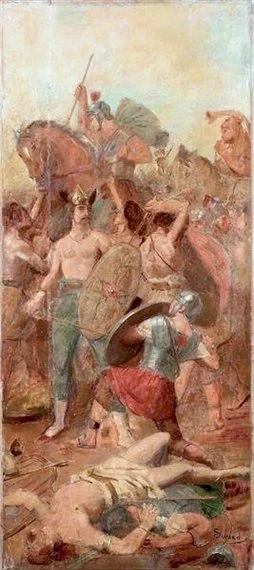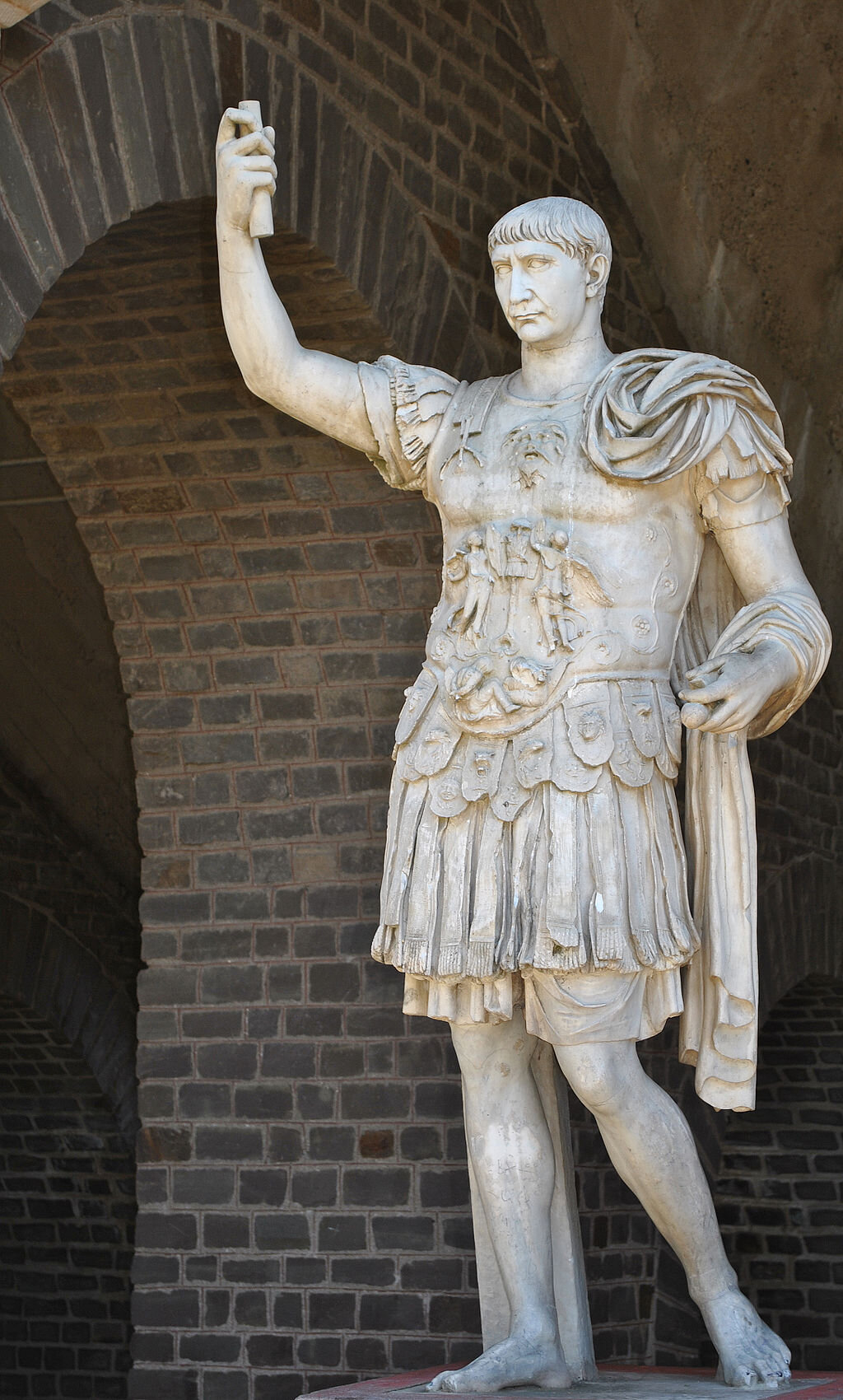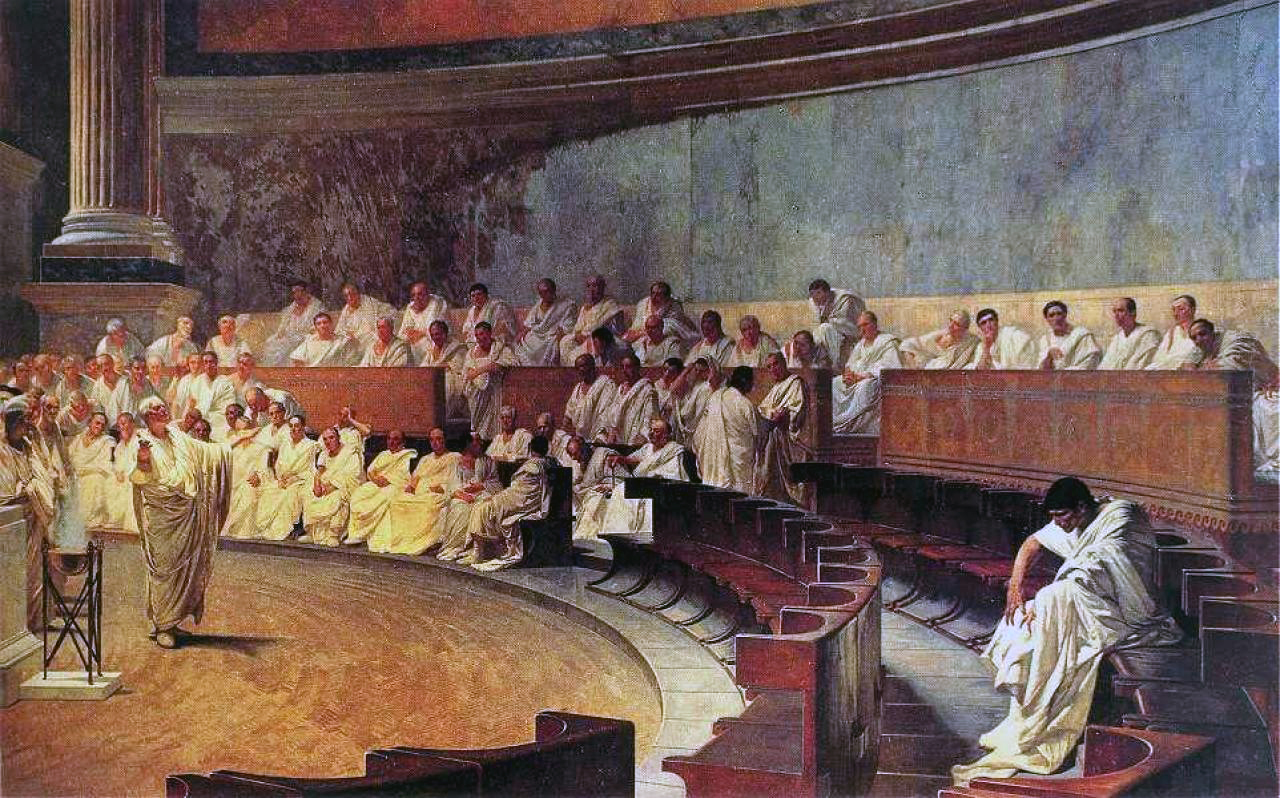When asked to picture Roman emperors, many may think of men dressed in glistening togas, perhaps those famous figures to which we owe the months July and August. Others may think of tyrannical figures like the emperor Nero, or the Stoic Marcus Aurelius. What these emperors have in common is the time in which they exist, all residing in a time of general prosperity for the Roman empire from roughly 27BC-180 AD. However, many often don’t hear of the figures and people in the between classical antiquity and the early Middle Ages, roughly 235-700 AD. There is a very rich history here. A history that laid the groundworks for medieval Europe. A history filled with migrations of highly impactful populations. A history where a seemingly invincible empire was changed to its very foundations. In a time of widespread chaos, known as the ‘crisis of the third century’, the Roman Empire was shaken to its core. Emperors were proclaimed left right and center (an astounding 26 recognized rulers in a 50-year period), and those left in charge were constantly in a battle to maintain control. The military remained the strongest institution in this time, and what continued to emerge were powerful generals taking the throne. Many of them called the Balkans their home, known as ‘Illyricum’, and would later be referred to as the ‘barracks emperors’, or the ‘Genius Illyrici’.
Dylan Cross explains.
A medallion of Diocletian. Source: CNG, available here.
Diocletian
After a long twenty-one-year reign, Diocletian retired to his palace in Split, Croatia, in 305 AD. He stabilized the frontiers, reformed the administration system and brought in a new era for the Roman Empire. He was the first emperor to voluntarily retire his position; one of the few to die peacefully. He had set up a system known as the Tetrarchy (rule of four), in which the empire was divided between four emperors of equal position to ensure there was a base of power in all corners of Europe. Diocletian had ruled over the eastern portion of the state. Turkey, Egypt and Syria, conveniently the richest provinces in the pot. This begs the question, why retire to the coast of Croatia rather than the rich eastern empire he had governed for so long? We know he was born here, in the ancient town of Solin (now a suburb of Split). The sources claim he was of a lowborn position, perhaps even a freed slave (Eutropius. 9.19). The town must have held importance to him, enough for him to build an extraordinary palace (although more a fortress in retrospect) and remain here until the end of his life after abdicating. Famously, when asked by his old comrades to return to the throne, he is claimed to have said:
“If you could see at Salonae the cabbages raised by our hands, you surely would never judge that a temptation”. - Epitome de Caesaribus. 39.5
Illyria as a region was certainly held with pride by those from it. The empire was vast, and soldiers came from every corner of its territory. But Illyria is perhaps one of the most significant in the time of the third century crisis and beyond it, and many emperors owed their power to the growing power the military could grant, and the significance that hailing from Illyria could bring them.
What was the crisis of the third century?
Let’s go back in time. It’s the middle of the third century, and the frontiers of Illyria held one of the highest concentrations of soldiers. There is an estimate of seventeen legions (Southern, 2016, p.431) attested under the reign of Gallienus (253-268 AD), who reigned during one of the most troubling times of the empire. It’s important to see what the troubles were at this time and what made it a crisis. During the third century, there was intense internal conflict in Rome. Many emperors were assassinated, revolts were commonplace, and usurpations were a constant threat. Another large pressure was coming from external threats. Large numbers of tribes were pressing inwards onto the frontiers, most notably the Rhine and the Danube frontiers which encompassed the largest stretch of what the Romans had to defend. These troubles reached a critical stage between 250-270 AD, when there were 2 break-away empires, the Gallic and Palmyrene Empire.
What did this mean for the army?
This had significant consequences for the army and demonstrated that power remained with the soldiers. It was famously said by the emperor Septimius Severus on his deathbed:
“Enrich the soldiers, scorn everyone else”- 211 AD - Cassius Dio. Roman History. 77.15.2
Without the army’s support, the emperor couldn’t maintain control, which was the reason for such political insecurity and so many usurpers. Therefore, the army of the third century had to evolve. Evidently, there was a shift to recognize the talents of capable generals rather than promoting prestigious names and wealthy citizens. The senatorial order had traditionally held the role of controlling high level magistracies and military posts. For example, a Senatorial Legatus(magistrate) had traditionally commanded the legion, but this was increasingly replaced by an equestrian prefect (Goldsworthy, 2003, p.201). Emperor Gallienus (253-268 AD) had further propelled the soldiers onto the career ladder. He continued the movement to remove the power of the Senate from the military (Aurelius Victor. De Caesaribus. 33), instead granting more roles to gentry classes known as the ‘Equites’. This would make it far more accessible for capable generals to attain military positions, replacing the old elite structure with those from a less elite stock. As well as this, Gallienus began recruiting soldiers for his personal entourage, known as the ‘Protectores’. This had existed before his time, but with the increased military demand due to the many threats of the century, it was advanced to new levels. Gallienus began recruiting soldiers from Illyria into his Protectores (Stoev, 2020), in turn making them a significant part of the military and their prestige. Stoev presents a detailed description of how ‘barbaric’ elements of the population of Illyria were becoming integrated with the more Romanized soldiers of the region. Therefore, Illyrian soldiers were afforded more opportunities to gain prestigious positions in the army by their experience.
How did this influence the emperorship?
In an intense time of crisis, the army of the third century often proclaimed who they thought would rule better, or more realistically, who could pay them the best. We may find some origins of the rise of the Illyrici in the reign of emperor Decius (249-251 AD). Decius was born in the province of Illyricum (Serbia), he was a senator and military commander who was appointed to crush a rebellion in the Danube. In Roman fashion, Decius’ soldiers demanded that he take the throne, and after defeating the emperor Philip, he was made emperor. His significance in this story may seem insignificant. A wealthy Senator promoted in a usurpation does not seem a candidate for a great soldier emperor. However, what shines through is reign is the official promotion of the Danube the soldiers, the ‘Genius Illyrici’. The ‘spirit of the Illyrians’ was recognized on official coinage during his reign. This holds great significance for what it meant to be a soldier from these provinces and marks the significance Illyria had for the future of becoming an emperor. Decius himself had clearly been appeasing the large body of troops stationed in the Danube; however, its recognition becomes clear when you look later into the emperors of the third century.
Claudius Gothicus
After the death of Gallienus in 268 AD, a general named Claudius Gothicus took the throne. He was likely born in the Danube and became a successful general under Gallienus (Historia Augusta. Gallieni 7) through the promotion of non-elite classes into the military. Claudius earned the title ‘Gothicus’ after defeating a large army of Goths in the Balkans. He is often associated with the term ‘barracks emperors’, the collection of emperors who rose from military backgrounds rather than from wealthy elite families. Early emperors often were contained in a lineage and part of a wealthy household, such as the Julio-Claudian dynasty, or the Nerva-Antonine Dynasty. However, in the third century there was often not a fluid succession of the throne.
Despite the lack of a peaceful transition of the throne, the Illyrian soldier emperors of the late third century often were easily picked for the throne due to their popularity and promotion by the previous emperor. Some sources suggest that Claudius played a part in the murder of Gallienus (Zosimus. New History 1.40-41), and others suggest he was not involved and was given the throne by Gallienus (Historia Augusta. Gallieni. 14, Aurelius Victor. 34). He was made emperor for being ‘a friend to his native land’, and one anecdote states that the valor of the Dalmatian (region in Illyria) horsemen was especially great, because this was Claudius’ homeland (Historia Augusta. Claudius 11.9), further claiming he had control of a significant force of Illyrian soldiers during the reign of Gallienus.
Claudius advanced the role of soldiers significantly during his reign. There are numerous dedications to generals with the name ‘Marcus Aurelius’, meaning these men were made citizens by the Edict of Caracalla in 212 AD, which made all free born people in the provinces Roman citizens. This represents a change in the social structure of government, the old elites were being replaced by strong soldiers only recently granted equal legal rights. One of these men, Julius Placidianus, was put in charge of defending the Italian peninsula, however not necessarily from the Danube (Potter, 2014 p.261). Holding power and respect among the influential troops was certainly significant in holding onto the throne, evident in the promotion of them into these powerful positions. This practice applies to the soldiers of Illyria, where the future emperors Aurelian and Probus would gain such dedications (Historia Augusta, Probus. 6.1; Aurelian, 16.1). One could argue that a domino effect was in place where the powerful soldier emperors promoted from recognized talent, continuing for many reigns in this century.
Aurelian ‘Restorer of the world’
Despite Claudius’ quick and powerful accession, he had only ruled for two years and succumbed to the plague in 270AD (Zosimus. 1.46). The next to take the throne is perhaps one of the most famous Roman emperors. Aurelian (270-275 AD) is often attributed to saving the Roman world. He had restored power from the two break-away empires in Gaul and the east, built the famous walls around Rome, and attempted to stabilize the frontiers by withdrawing from provinces like Dacia. His prestige, like Claudius, originates from the promotion of soldiers from unlikely backgrounds, once again Illyrian heritage is prominent. The sources acknowledge his humble background, from near the Danube River, and he rose to military command under Gallienus (Zosimus. 1.40). During Claudius’ reign, Aurelian was promoted to commander of the cavalry, which was made possible by his popularity with the army (Watson, 1999). He is enlarged in his merits by some sources, and his popularity with the army is presented as savior-like even under emperor Gallienus:
“Both we ourselves and the whole commonwealth as well are so in his debt that scarcely any rewards are worthy of him”- Historia Augusta. Aurelian. 9.3
However boastful this is, it is certain that Aurelian was popular among the army and the ruling powers. Having been a popular soldier of high esteem, would have earned him the position of Commander of the Cavalry forces later on. He had been present with Gallienus while suppressing a rival, further noted for his popularity and prestige (Aurelius Victor. 33). Internal promotion based on prestige was therefore highly prevalent, and more often than not many generals have their origin in Illyria and the promotion of the ‘Genius Illyrici’.
There is further evidence under the emperor Probus, born in Sirmium, and advanced at the same time as Claudius and Aurelian, being recognized as worthy by Aurelian (Historia Aug. Probus. 6.6). He was hailed emperor by the Danube legions (Aurelius Victor. 37). Perhaps the most interesting note in the life of Probus is that he:
“Trained most illustrious generals, Carus, Diocletian, Constantius”- Historia Augusta. Probus 22
Diocletian and the Illyrian Tetrarchy
The last two names ring significant for the course of later Roman history. As we have seen, Diocletian was born in Illyria, and from a low-born background. He had advanced to become commander of the emperor’s bodyguard (Protectores) under the reign of Carus (282-282 AD). By this time, being a member of the Protectores was significant in allowing greater prestige previously difficult (Williams, 1985). After the death of the emperor Carus, Diocletian was hailed emperor. He had to move to suppress Carus’ son Carinus, which Diocletian completed at the battle of the River Margus in 285 AD. It can be argued that the advancement and prestige of Illyrian soldiers played a large part in Diocletian’ success and stable government. Before the battle of the Margus River, a general named Flavius Constantius joined Diocletian in his conquest for sole power. Some suggest he had changed sides, originally supporting Carinus. Constantius had been the governor of Dalmatia, an Illyrian by birth, and likely served with Aurelian on his extensive campaigns.
Diocletian had created the Tetrarchy in order to increase stability. If he was to do this, he needed capable leaders he could trust. The first, and most important, was to be Maximian. Maximian is regarded as an Illyrian, unfortunately regarded as ‘uncultured’ by some sources that reflect xenophobic attitudes (Aurelius Victor. 39). The final member to complete the band was Galerius. However, the prestige of the four Tetrarchs was immense. In fact, all four members have their origins in Illyria and were propelled by the awards of the previous emperors. Ancient historians imply their prestige:
“They had been sufficiently schooled by the hardships of the countryside and of military service to be the best men for the state”- Aurelius Victor. 39
Soldier emperors became the norm for imperial governing during this period. Maximian in fact was the first soldier emperor to be mentioned in a Panegyric (a text proclaiming the greatness of the emperor), which notes the ‘Services of Maximian’s native land (Pannonia) to the state’ (Pan. Lat. 10.2.2-4).
In the aftermath of the Tetrarchy, having essentially collapsed after Diocletian abdicated to a life of cabbage farming, the veneration of Illyrian heritage and strong military figures continued to be significant. Claudius Gothicus became associated as the ancestor of Constantine the Great (Historia Augusta. Claudius. 10.7). This was likely a fabrication to associate his house with a legitimate dynasty after a troubling accession, Constantine had fought with Maximian (his father-in-Law) in the fallout of the Tetrarchy and needed a new dynasty to hold his claim. The panegyric linking the two figures says that Claudius was the first to restore discipline to the Empire (Pan. Lat. 6(7).2), which allows Constantine to claim inheritance to the prestige of his supposed Illyrian soldier ancestry. Constantine himself was born in Illyria like his father Constantius and was hard pressed on the region throughout his reign. He crossed the Danube River several times and claimed control over previously lost territory north of the river (Thompson, 1956; Eusebius. Life of Constantine. 1.8), the sources paint him as subduing ‘all of Scythia’ (a nonsensical claim that demonstrates Roman ignorance to culture and populations). Having to fight numerous campaigns against the native Goths across the frontier made his association with the very emperor with the title ‘Conqueror of the Goths’ that much sweeter to Constantine when hearing this panegyric. And so, this fabricated lineage, while being mostly political in nature, upholds the prestige of the soldier emperors and the Genius Illyrici.
Conclusion
The Illyrian trend didn’t die with the collapse of the Tetrarchy. It proved to be a staging ground for many to take the throne. The problems of the third century gave rise to a new order, where military changes meet cultural backgrounds. It is no coincidence that successful generals were made emperor, they owed their power to the recognition of the ‘Genius Illyrici’. Perhaps Diocletian, when picking his partners, felt more comfortable choosing men of similar backgrounds to his own heritage, old comrades (Williams, 1985, p.37). Emperors continued to be born in Illyria. Valentinian I (364-375 AD) continued the spirit of his Illyrian soldier heritage in lengthy campaigns to maintain order in a shifting world. His father had been an Illyrian soldier, (Ammianus Marcellinus. Res Gestae. 30.7), and this continued into a dynasty that would rule to near the end of the Western empire with the death of Valentinian III in 455 AD. Therefore, the rise of the Illyrici, that began as a desperate need for capable generals, generated a host of capable emperors that brought the Genius Illyrici from a necessity to a desired attribute.
Did you find that piece interesting? If so, join us for free by clicking here.
Sources
Aurelius Victor. De Caesaribus. Translation: H. W. Bird (1994) Liverpool University Press [archiveorg aurelius-victor-h.-w.-bird-de-caesaribus-1994-liverpool width=560 height=384 frameborder=0 webkitallowfullscreen=true mozallowfullscreen=true]
Ammianus Marcellinus. Res Gestae. Translation: J. C. Rolfe (1950) Loeb Classical Library. Harvard University Press https://www.loebclassics.com/view/amminanus_marcellinus-history/1939/pb_LCL300.3.xml?rskey=MNu6x8&result=1
Cassius Dio. Roman History. Translation: Earnest Cary (1914) Loeb Classical Library. Harvard University Press
Eusebius. The Life of Constantine. Trans. Averil Cameron and Stuart G. Hall. (1999). http://archive.eclass.uth.gr/eclass/modules/document/file.php/SEAD260/%CE%95%CF%85%CF%83%CE%AD%CE%B2%CE%B9%CE%BF%CF%82%2C%20Life%20of%20Constantine%20(trans.%20Averil%20Cameron%20-%20Stuart%20Hall).pdf
Eutropius. Short History. Livius.org https://www.livius.org/sources/content/eutropius-short-history/
Pseudo-Aurelius Victor. Epitome De Caesaribus. Translation: Thomas M. Banchich (2009) https://topostext.org/work/745
Trebellius Pollio. Historia Augusta. Translation: David Maggie (2022) Loeb Classical Library. Harvard University Press
Zosimus. New History. Translation: Ronald T. Ridley (1982). Australian Association for Byzantine Studies https://www.scribd.com/doc/300818235/Zosimus-HISTORY-1982
Panegyric 10. Translation R.A.B Mynors / C.E.V Mynors and Barbara Saylor Rodgers. In ‘In praise of later Roman Emperors: The Panegyrici Latini’ (1994) University of California Press. Oxford
Panegyric 6. Translation Nixon/Rodgers (1994). In ‘Contested Monarchy: integrating the Roman Empire in the fourth century AD’ (2015) Oxford University Press. New York
Goldsworthy, Adrian. 2013. The Complete Roman Army. London. Thames & Hudson Ltd
Potter, D. S., 2014. The Roman Empire at bay, AD 180-395. Abingdon. Routledge
Southern, P., 2016. The Roman Army: A history 753 BC - AD 476. Stroud: Amberley Publishing
Stoev, K., 2020. Protectores on the Balkans, 3rd Century. [Online] Available at: https://labalkans.org/en/labedia/history/political-history/protectores
Thompson, E., 1956. Constantine, Constantius II, and the lower Danube frontier. Hermes, 84(3), pp. 372-381.
Watson, Alaric, 1999. Aurelian and the third century. London. Routledge
Williams, S., 1985. Diocletian and the Roman Recovery. London: B T Batsford Ltd













